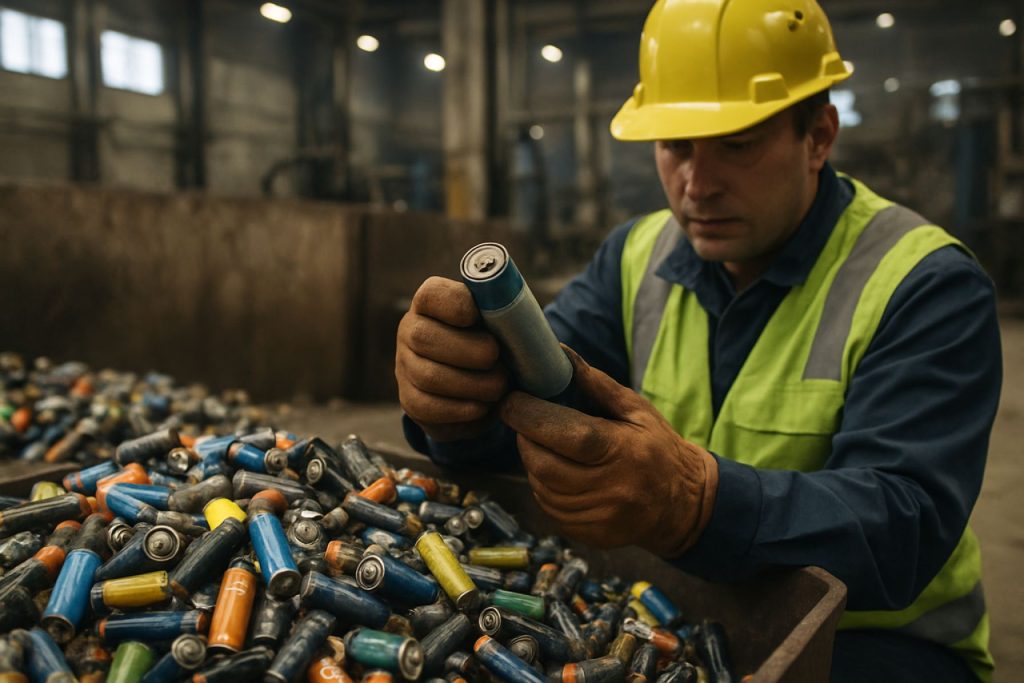
- Battery recycling is becoming a central industrial strategy, projected to grow from $22.75 billion in 2024 to $41.66 billion by 2030, driven by sustainability and energy independence goals.
- The Asia-Pacific region leads global revenue, fueled by strict government policies, technology subsidies, and a closed-loop approach to raw materials recovery.
- Australia and India are emerging players, focusing on high-purity refining and strong producer responsibility laws.
- Europe enforces the world’s strictest recycling regulations, stimulating investment in green technologies and material reuse, while North America advances through innovation and strategic supply chain partnerships.
- Global competition is intensifying as recyclers and manufacturers pursue mergers and acquisitions to secure battery feedstock and critical minerals.
- Technical and financial hurdles persist, but innovations in hydrometallurgy, AI, and plant automation are accelerating progress toward a circular battery economy and greater sustainability.
Colossal piles of spent batteries—once the end of the road for our devices and electric cars—are powering a revolution sweeping across continents. Battery recycling has shifted from the background of environmental activism to the frontline of industrial strategy, as nations and manufacturers scramble to turn yesterday’s waste into tomorrow’s power source.
An industry projected to vault from $22.75 billion in 2024 to $41.66 billion by 2030 is more than just a market forecast. It’s a pivot point in the global push for sustainability and energy independence. With electric vehicles (EVs) rolling out of factories at a record pace and digital devices multiplying by the minute, the world is hurtling toward a moment where discarded batteries aren’t trash—they’re treasure.
Asia-Pacific: The Beating Heart of Battery Recycling
Stretching from the industrial sprawl of China to the tech-driven urban jungles of Japan and South Korea, the Asia-Pacific region dominates, commanding over 57% of global revenue. Here, powerful government mandates and lavish technology subsidies have forged a recycling ecosystem that no other region can match. China’s “New Energy Vehicle” regulations force manufacturers to not just sell cars but reclaim the batteries at end-of-life, creating a closed loop that keeps valuable lithium, cobalt, and nickel flowing back into production lines. Japan and South Korea, propelled by their electronics giants and auto titans, are racing to expand capacity and refine the technology that disassembles a battery, molecule by molecule.
Australia’s Ascent and India’s Overhaul
Australia, rich in lithium and nickel ores, is quickly becoming a vital node in the battery recycling map. Its emerging plants focus not only on collection but also on high-purity refining—turning waste into ready-to-use material for the next generation of batteries. In India, strict rules enacted in 2022 force producers to account for the fate of every battery they introduce, marking a seismic cultural shift in waste responsibility.
Europe and North America: Regulation Breeds Innovation
While the European Union isn’t the largest in volume yet, its policies are the world’s strictest. The new EU Battery Regulation mandates minimum recycling rates and incentives for using recycled materials in new products, with companies investing billions in “gigafactories” designed to close the material loop and shrink the region’s environmental footprint.
Across the Atlantic, North America moves under the watchful eye of robust environmental laws. The U.S. and Canada attract investment in groundbreaking hydrometallurgical and direct-recycling technologies—processes that promise to squeeze ever more value out of each spent cell. Partnerships between automakers and recyclers are springing up, driven by the urgent need for a domestic supply of critical minerals in a world where geopolitical uncertainty rattles supply chains.
The Latin American, Middle Eastern & African Frontiers
Though smaller players in the recycling volume game, these regions possess mineral richness that rivals any on earth. Their growing investment in recycling infrastructure hints at a future where the supply chain for batteries is not only sustainable but far more secure—and far less dependent on current giants.
Mergers, Money, and the Battle for Raw Materials
Boardrooms buzz as the world’s biggest recyclers—names like Umicore, Glencore, Li-Cycle, and Redwood Materials—lock down partnerships with car manufacturers, electronics firms, and municipalities to guarantee a nonstop flow of used batteries. Mergers and acquisitions, like Ace Green Recycling’s $250 million union with Athena Technology Acquisition, signal a new phase: this is high-stakes, global competition for control of the metals at the heart of the energy future.
Yet alongside promise, the sector faces daunting financial barriers. Setting up a basic lithium-ion battery recycling plant in India can cost upward of $370,000, and the expenses only cascade with scale—equipment, space, regulations, labor, and the energy needed to process each blackened cell.
High Tech, High Hurdle
A hidden challenge lies in the technical intricacies: dismantling batteries constructed for safety, not disassembly. Recycling them cleanly without environmental risk and extracting the precious ingredients requires world-class know-how and continuous innovation. This is where the global leader companies shine, investing in AI-aided sorting, advanced hydrometallurgy, and instant diagnostics to boost yield, safety, and sustainability.
The Real Prize: A Circular Battery Economy
Original Equipment Manufacturers—think Volkswagen’s planned $195 billion electrification spree—are no longer waiting for global supply chains to catch up. They’re forging direct alliances with recyclers, creating circular loops where each battery’s end is but a beginning for new products. As regulations tighten and costs gradually ease with scale and innovation, this model promises to realign the entire global battery market toward true sustainability.
Factories like Hydrovolt’s in Norway, bristling with automation, and Dubai’s new integrated facility point to a world where smart recycling isn’t the exception but the foundation. The race is on—from design labs to scrapyards and back again.
The Takeaway: Waste Is the New Wealth
As batteries light up our lives and signpost the path to decarbonization, their afterlife is emerging as one of the fiercest frontiers in industry. The companies and nations who master the art of reclamation—that elusive blend of technology, policy, and vision—will not just clean up yesterday’s leftovers. They will mint the raw materials of the future, powering the global economy’s most daring energy transition.
For all who care about sustainability, and the energy to make the future possible, the story of battery recycling is not just about waste. It’s about seizing opportunity in the ashes of yesterday’s products, and building a world that runs not just on innovation—but on renewal.
Battery Recycling Gold Rush: Secrets, Shortcuts & Shocks the Industry Won’t Tell You
# The Untold Truths & Next Steps in Battery Recycling: Strategy, Hacks, and Future Forecasts
Battery recycling has rapidly moved from a niche environmental pursuit to a multi-billion-dollar industrial race, with global implications for sustainability, security, and economic advantage. As you look to stay ahead—whether as an eco-conscious consumer, business strategist, or investor—here’s what you need to know beyond the headlines.
—
Key Additional Facts & Unexplored Insights
1. How Battery Recycling Actually Works (The Inside Scoop)
Common Tech Methods:
– Pyrometallurgical (Smelting): Melts batteries to recover metals, but emits CO₂ and loses some materials.
– Hydrometallurgical (Chemical Leaching): Uses liquids to dissolve and extract metals; less polluting and more selective.
– Direct Recycling: Retains battery cathode structure, saving energy and cost. Still under development but promising for EV battery chemistries (source: Nature Energy).
Newest Trends:
– AI-powered robotic disassembly is gaining traction (Redwood Materials, Li-Cycle).
– Water-based processes are being developed to minimize hazardous waste and emissions.
—
2. Industry Trends & Future Demand
– Market Growth: Battery recycling is expected to expand at a CAGR of 10–12% through 2030, with the Asia-Pacific maintaining dominance but Europe and North America growing fastest (BloombergNEF).
– EV Explosion: By 2030, over 11 million tons of spent lithium-ion EV batteries will require recycling yearly (IEA Global EV Outlook 2023).
– Vertical Integration: Carmakers like Tesla and Volkswagen are launching in-house recycling programs to secure supplies and reduce reliance on geopolitically sensitive sources.
—
3. Real-World Use Cases & Industry Players
– Volkswagen is building a closed-loop system in Germany, where old EV batteries are repurposed for grid storage before being fully disassembled and recycled.
– Redwood Materials (USA) supplies Panasonic/Tesla with recycled battery-grade materials, shrinking the supply chain’s carbon footprint.
– Umicore (Belgium) is a leader in European recycling and is pioneering “urban mining,” extracting metals from expired electronics.
—
4. Features, Specs & Pricing
What Can Be Recovered?
– Lithium, cobalt, nickel, copper, aluminum, manganese, graphite—with up to 95% recovery efficiency now possible using latest technologies.
Cost Factors:
– Collection and sorting logistics (20–30% of cost).
– Energy-intensive processes (biggest cost for smelting vs. hydrometallurgy).
– Regulatory compliance and EHS (Environmental, Health & Safety) protocols.
—
5. How-To: Battery Recycling at Home or for Small Businesses
Step-by-Step Battery Recycling:
1. Identify Local Drop-Off Points: Utilize municipal programs, electronics retailers, or organizations like Call2Recycle in North America.
2. Prepare Batteries for Recycling: Tape terminals, place in original packaging if available, store away from flammable materials.
3. Drop-Off: Only deposit at certified collection facilities; improper disposal is illegal in many regions.
4. Track Industry News: Some companies offer incentives or credits for recycling.
Quick Hack: Some mobile carriers and electronics retailers offer trade-in programs, turning old devices into recycling value.
—
6. Security, Sustainability & Controversies
– Data Security: Batteries in electronic devices may retain data; always wipe devices prior to recycling.
– Environmental Impact: Recycling processes, especially pyrometallurgical, can create pollution if not properly managed.
– Global Inequality: Some developing countries are used as waste dumping grounds, sparking environmental justice concerns (Amnesty International).
– Regulatory Gaps: Not all battery chemistries are regulated equally—single-use and lead-acid batteries are often less carefully tracked.
—
7. Market Forecast, Reviews & Comparisons
– Top Companies: Umicore, Li-Cycle, Glencore, Redwood Materials, Ace Green Recycling.
– Hydrometallurgy vs. Smelting: Hydrometallurgy is cleaner and recovering more lithium, making it the future favorite.
– Direct Recycling: Offers the lowest energy footprint but is not yet widely commercialized—watch this space.
—
8. Actionable Recommendations & Life Hacks
– For Consumers: Collect used batteries separately, maximize device lifespan, join local recycling programs.
– For Businesses: Partner with certified recyclers, implement battery tracking, educate customers, explore government incentives.
– For Policymakers: Tighten collection requirements, incentivize local recycling infrastructure, mandate recycled material quotas.
—
9. Pros & Cons Overview
Pros
– Cuts raw material demand and environmental impact.
– Reduces electronic waste in landfills.
– Powers a sustainable, circular economy.
Cons
– High initial costs and technical challenges.
– Pollution risk if improperly managed.
– Supply chain vulnerabilities remain if recycling isn’t scaled globally.
—
Most Pressing Reader Questions—Answered
Q. How profitable is battery recycling?
A: Margins are growing as technology matures and lithium prices remain high. By 2028, most large recyclers expect to break even or profit (Reuters, BloombergNEF).
Q. Can battery recycling handle the coming EV boom?
A: Scaling is an urgent challenge, but innovations and investments are bridging the gap. Most experts project robust capacity by 2030, albeit with potential bottlenecks.
Q. Is battery recycling safe?
A: Industrially, yes—when following regulations and best practices. DIY or informal recycling is dangerous and highly discouraged.
—
Quick Tips for Individuals & Businesses
1. Never throw batteries in the trash—fire risk!
2. Tape over terminals and store used batteries separately.
3. Check manufacturer and retailer takeback policies—many offer easy returns.
4. Advocate for local/federal recycling laws to spur system-wide change.
—
Learn More & Stay Updated
For ongoing information about global sustainability, visit trusted sources such as the United Nations or European Union.
—
The Bottom Line
Waste is wealth in the battery economy—and staying informed, safe, and connected to the right programs can put you at the forefront of the sustainability revolution. Invest time in responsible disposal, advocate for better systems, and your efforts will power a greener future—literally and figuratively.



